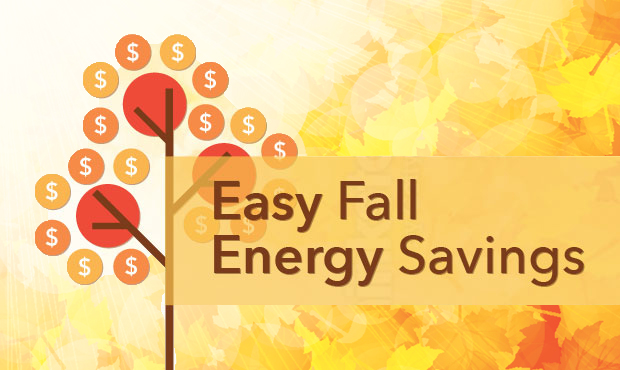
Saving energy is a priority for most homeowners and renters. Unfortunately, many people think going ‘green’ with their homes necessitates expensive home remodeling projects, such as installing a new roof. While these renovations can certainly make a significant difference in your annual energy costs, there are tons of easy and cost-effective ways to reduce your energy usage, increase your savings, and help you make a positive environmental impact during the fall season, and throughout the rest of the year.
1. Take advantage of the sun
Energy from the sun is free, and taking advantage of or maximizing the use of what’s known as passive solar techniques can enhance your energy savings.
- In the fall, open the curtains on your home’s south and/or west-facing windows to permit the sun’s light to naturally heat your home. At night, close these curtains to reduce drafts and escaping heat.
- Consider planting deciduous trees close to south, west, and east-facing windows. These will provide shade during the summer, but, as the leaves drop during fall, they’ll allow sunlight through your windows during the colder months.
2. Take control of the thermostat
- Try to keep your thermostat adjusted to as low as possible during the times you’re awake or home. When you’re away or asleep, turn it back between 10 and 15 degrees. If you keep these adjustments in 8-hour increments, you can save an average of 10 percent on energy costs.
- Consider installing a programmable thermostat for easy and automatic temperature set backs and returns.
3. Locate and seal home air leaks
For this step to be most effective, you’ll want to contact a professional about having a home energy assessment performed. This walk-through assessment will use special tools like a thermal imaging test to determine where your home leaks the most energy. A professional will also inspect your home insulation and HVAC system to ensure they have been properly installed, maintained, and are operating at their peak efficiency.
- Once you have an idea of where your most significant air leaks are occurring, use caulk and spray insulation to seal around any plumbing penetrations, chimney gaps, and any cut-aways that have been made for electrical wires.
- Use weatherstripping or caulk to seal around your windows and doors.
4. Have a maintenance plan for your heating system
While heating systems are generally trouble-free, your equipment does require good regular maintenance to operate at its peak energy efficiency.
- Contact your local HVAC experts for annual inspection of your heating equipment.
- Inspect your furnace’s air filter during the fall to be sure it is clean and free of debris. It should be replaced at least once a month during the peak of winter, but every three months otherwise.
- If you have a wood or pellet-burning heater, inspect the flue vent and clean inside with a wire brush as needed.
5. Lower your water heater’s temperature
Most homes have their water heater set at unnecessarily high temperatures, causing high energy costs. In fact, most storage water heaters account for between 14 and 25 percent of a home’s annual consumed energy. You can lower that amount by:
- Turning the temperature down to 120 degrees Fahrenheit. This will both lower your energy costs and prevent any scalding.
- Installing a solar water heater. Today there are a lot of tax breaks and rebates offered to homeowners and renters who install solar water heaters in their homes. This efficient equipment can be used in any climate to generate hot water via the sun, making it an especially cost-effective solution.
To learn more about reducing energy costs, or to schedule an energy assessment for your home, contact Wattson Home Solutions today.







